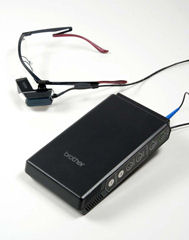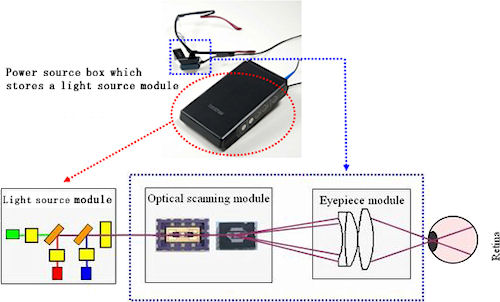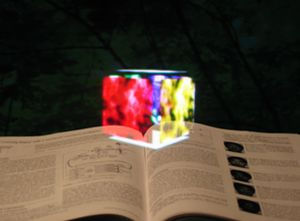 PRESS RELEASE: Brother Develops Mobile Spectacle-type Wearable Retinal Imaging Display
PRESS RELEASE: Brother Develops Mobile Spectacle-type Wearable Retinal Imaging Display
Brother Industries, Ltd. (president: Toshikazu Koike) has been actively developing technologies for retinal imaging display (RID) to commercialize it in fiscal year 2010. Brother has announced that it succeeded in downsizing power source box used for the RID, and developed the prototype of a mobile RID.
 |  |
Mobile spectacle-type wearable retinal imaging display (left), and shown in use (right).
Photos provided by Brother Industries Ltd. |
RID is an image projection technology that focuses light, of an intensity harmless to the eyes, onto the retina and then moves the light at high speed to create afterimages. Images projected onto the retina appear as if they existed in front of the user.
<Features of Brother's RID>
The transparent display enables users to see RID images without affecting the visual field.
Users can view private images and confidential data at anywhere.
Even though the RID is small and lightweight, users can view images on a virtual large screen anytime, anywhere. (16 square inches screen viewed in 1m ahead)
Due to this eyeglass-shaped wearable design, it enables users to read documents such as operation manuals at the narrow spaces, or to be hands-free when they want to use both hands.
Brother has developed the RID by applying optical system technologies based on its laser printing technology, and piezoelectric technologies based on its inkjet printing technology.
Brother created an attraction for demonstrating a stationary type RID at EXPO 2005 in Aichi, Japan. In 2008, Brother succeeded in developing a spectacle-type wearable RID prototype.
This new prototype cleared the conventional assignment of practical application; downsizing a power source box which stores light source modules.
<Technical details>
Our RID consists of three modules: a light source module, an optical scanning module, and an eyepiece module.
 |
Retinal imaging display configuration.
Photo provided by Brother Industries Ltd. |
Light source module vastly downsized
Light source module requires laser light sources of the light's three primary colors: red, green and blue, to view images in full color. Brother used a green solid state laser for the previous prototypes since a green laser diode was not in practical use.
Therefore, it was difficult to downsize the light source module and this was a big hurdle for the commercialization. However, Brother succeeded in downsizing the light source module by adopting a green laser diode for the first time in the world.
This reduced RID's volume: less than one twentieth, and weight: less than one thirteenth of the previous prototype. Although the previous prototype was driven by an AC power source, Brother succeeded in developing the mobile type RID which is driven by the batteries.
Optical scanning module and eyepiece module
An optical scanning module and an eyepiece module were already downsized by applying optical scanning system technologies based on the laser printing technologies. Brother has been developing piezoelectric MEMS technologies based on its inkjet printing technology. With this technology, it successfully developed in-house an optical MEMS scanner (high-speed scanning mirror device), with world-class operating frequency, to create clear images.
<RID details>
| Outline of the power source box |
| Light source | Red / Green / Blue LD |
| Size | Approx. 95×170×30mm |
| Weight | Approx. 350g |
| • Outline of the RID specification (Except Spectacle Frame & Cable) |
| Resolution | SVGA (800 × 600) |
| Frame rate | Approx.60Hz |
| Angle of view | Approx. 18°×13.5° |
| Volume | Approx. 22 cc |
| Weight | Approx. 35g |
 |
Conceptual image of the visual field seen through the RID.
Photo provided by Brother Industries Ltd. |
Customer inquiries: H. Kato and H. Tani; New Business Planning & Promoting Dept., Brother Industries, Ltd. Phone: 052-824-2536; Fax: 052-824-2600, E-mail: [email protected]
(First posted on Thursday, October 22, 2009 at 21:22 EDT)